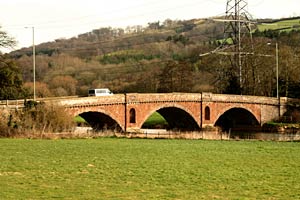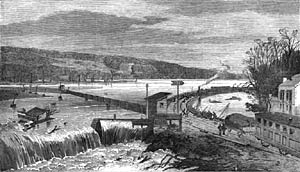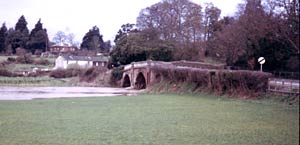
- Home
- Memories
- Scrapbook ▽
- Topics ▽
- People ▽
- Events
- Photos
- Site Map
- Timeline
Also see Bridges of Exeter
A bridge was first recorded in 1286 at Cowley, and it was the second lowest stone bridge over the river after the Exe Bridge. The Cowley Bridge actually crosses the River Creedy, just a few yards from its confluence with the Exe. It was probably sited at a previous Roman crossing point and was the furthest extent of the beating the bounds of the city in the north west during the 19th century. In 1326, Bishop Stapleton left a bequest for the maintenance of the bridge and the roads leading to it, indicating that the route from Exeter to Crediton was still of some importance. Cowley means Cufa's clearing, for there were extensive woods in this area at the base of the Duryard royal hunting ground.
In 1545, part of the old Cowley Bridge fell down, and was repaired by the city. James Green the county surveyor and former assistant of John Rennie, was responsible for the present bridge in 1813-14. The old bridge had been destroyed by flooding on 25th January 1809 and again in 1810. It was at Easter 1813 that the Exeter and Devon magistrates summoned Green to draw up plans for a new bridge. Midsummer 1813 saw a contract with Green to rebuild the bridge for the sum of £9,000. On 9th June 1814, Green advertised for 'ten or fifteen Prime Mallet and Tool Hands who have been also used to fitting fine and heavy ashlar masonry'. It was opened on 5th October 1814. The design for Cowley Bridge is reminiscent of that for the Wolseley Bridge over the River Trent, built by Rennie in 1799, when Green was in his employ.
The new bridge was stronger, and had three spans of 50, 55 and 50 ft respectively. It carries the Crediton road over the Creedy and part of the flow from the Exe and Culm catchment areas. But the flooding continued through the 19th century, making the Illustrated London News on 27 January 1866 when the nearby railway bridge was badly damaged. Even now, the railway line to London from Exeter is often cut off due to flooding of the Exe.
There had been plans for an Exeter to Crediton Canal which would have passed under the old Cowley bridge. If the canal had been built, the bridge would probably been replaced two or three years before James Green actually did the job.
Cowley Bridge was built for the coaching era and is proving to be too narrow for modern traffic. However, its classic design has ensured that it is now a Grade II listed structure. There are two plaques on the bridge that record the laying of the first stone on 26th June 1814 by James Buller MP and John Quicke, Devon County Magistrate. However, care should be taken when viewing the plaques, as the bridge is very narrow and the traffic frequent.
The actual River Exe bridge at Cowley lies just to the east of the Cowley Bridge and was designed and built by Isambard Kingdom Brunel when he had to divert the river for engineering works for his railway line from Bristol. This bridge crosses both the railway and the Exe.
Source - Devon Life, Two Thousand Years in Exeter by W G Hoskins, the Illustrated London News, Jenkins History of the City of Exeter 2nd edition and James Green by Brian George. © 2005/6 David Cornforth - not to be used without permission.
 Cowley bridge by James Green.
Cowley bridge by James Green.  Flooding at Cowley in the 1860's.
Flooding at Cowley in the 1860's.
 A small overflow at Cowley Bridge in the 1960's. Photo by Alan H Mazonowicz
A small overflow at Cowley Bridge in the 1960's. Photo by Alan H Mazonowicz
│ Top of Page │